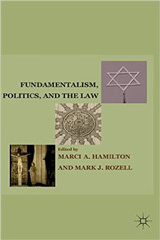When the Framers set to the task of crafting a Constitution in the wake of the failure of the Articles of Confederation, they did not share the triumphalism that sometimes infects United States politics to our detriment, but rather plunged into the project feeling, well, fallible. After all, the Declaration of Independence and then the Articles of Confederation were supposed to usher in a bright era in which God’s favor shone on the chosen ones, Americans. In fact, our first Constitution, the Articles, showcased human ambition and avarice, rather than a new and usable form of government, leading the Framers to gather in Philadelphia to clean up a mess, not dance the jig of demigods.
We are luckier for the attitude they brought with them to Philadelphia in the hot summer of 1787, because they made it the foundation of our Constitution: Don’t trust those who hold power, because they are likely to abuse it—if they can. They separated power in the federal branches, between the states and the new federal government, and church and state.
They instinctively knew that they could not produce a perfect document, and so they sent the draft to Congress uncertain that this ship would float. It only makes sense that they included, out of a sense of necessity, amendment procedures.
So I propose that, for this year’s Constitution Day, we follow the Framers’ lead, and, with the benefit of 20-20 hindsight, identify what was wrong with the Constitution of 1787. I know this sounds perverse, but they expected it to falter, after all, and so what better way to honor their wise, if somewhat cynical, vision, than to see how the document has improved over time? Because, at base, they weren’t really as cynical as they were hopeful, for they also expected Americans to have the sense to improve the Constitution as time progressed, and in a number of instances, we have. So here are my nominees for three critical issues that the 2013 Constitution deals with far more successfully than the Constitution of 1787 did.
The three flaws I identify, and the fixes, have made this a better country.
1. Slavery
The first topic—slavery—is an issue that was squarely in front of the Framers. They saw it, they understood it, and they sidestepped it. The ultimate result was our devastating Civil War.
The largest flaw in the Constitution, of course, was its perpetuation of slavery. Some of the Framers saw this as a fatal flaw, or at least one that would eventually test the document, but the Anti-Federalists were not about to ratify a Constitution that disturbed the Southern plantation economy. There were three elements in the Constitution that permitted slavery to persist: the 3/5 compromise clause, which counted 5 slaves as 3 people for purposes of apportionment in the House of Representatives [Art. 1, sec.2]; the slave trade clause, which forbade Congress from outlawing the importation of slaves until 1808 [Art. I, sec. 9] ; and the fugitive-slave clause, which prohibits one state from freeing a slave from another state. [Art. IV,sec. 2] To be sure, the words “slave” and “slavery” are not in the Constitution, but historians agree that each of these provisions plainly applied to slaves and/or the slave trade.
The slave trade clause portended the end of slavery starting in 1808, and Congress did, in fact, pass laws that criminalized it, but enforcement was lax, to put it mildly, and the slave trade lasted until after the Civil War. This incorporation of the slave trade into the constitutional structure and national system was doomed from the start, given the insistent and growing abolitionist movement, and our Civil War was the price we paid for the Framers’ and their generation’s inability to push slavery into the past more quickly.
The Reconstruction Amendments, particularly the Thirteenth Amendment, ended slavery both explicitly and definitively, but the amendment was necessary to fix the most troubling element of the founding Constitution. It can be said with absolute certainty that the 2013 Constitution, with its highly reticulated Equal Protection jurisprudence and strict scrutiny of laws that are based on race is a vast improvement over the 1787 draft sent to Congress and then ratified by the states.
2. Women’s Suffrage
The second topic—women’s suffrage—was not foreign to the framing generation, but not one of those issues necessarily on the agenda. The Framers left it to the states.
As of 1776, New Jersey permitted women to vote, as did a few more colonies including New York, New Hampshire, and Massachusetts, but all of the colonies forbade women the right to vote by the time of the Constitution’s ratification, other than New Jersey. Eventually, New Jersey rolled back the right as well.
The Constitution did not open the door for women to be a part of the political sector, but rather lodged the power over who could vote in the states, which meant that women, other than those in New Jersey, could not vote in national elections. The first women’s voting rights convention was held in 1848 in Seneca Falls, New York, but progress was slow. Slavery was dislodged with the Reconstruction Amendments, but not the ban on women’s voting. Indeed, the Fourteenth Amendment defined “citizens” as males.
The road to women’s suffrage was often uphill, lasting from the mid-19th century until 1920, one heroic woman following another as leaders of the movement. Finally, the Nineteenth Amendment was ratified, and women became fledgling political participants in this representative democracy. They seem to have found their way. With the election of President Barack Obama, they decided the presidency, and for the last 30 years more women have voted than men.
3. Civil Rights of Homosexuals
The third —topic—the treatment of homosexuals was not part of the constitutional debate, either explicitly or implicitly.
The plight of homosexuals at the time of the founding and framing was dire, in that many were subject to the death penalty for same-sex sex. While there are few examples of the death penalty being imposed on homosexuals, English Professor Louis Crompton called it the “capital reign of terror for the homosexual in the 17th and 18th centuries.” The Framers did nothing for these Americans.
The death penalty for sodomy eventually was taken off the table, first by New Jersey in 1796, though other states did not act until the mid- to late Nineteenth Century, including South Carolina, which did not repeal its death penalty for homosexuals until 1873. The repeal of the death penalty did not mean that homosexual sex was decriminalized. The criminal laws stood on the states’ books well into the Twentieth Century, with the Supreme Court in 1986 in Bowers v. Hardwick, upholding the Georgia criminal law banning homosexual sex.
But in 1996, the Court took a turn toward a more enlightened approach in Romer v. Evans, holding that Colorado’s law banning sexual orientation from being included in civil rights guarantees violated the Equal Protection Clause. The reasoning? That bare animus is not enough to justify a law. In other words, bigotry was not enough to make a law constitutional, or rational. And then in 2003 in Lawrence v. Texas, the Court took a far more humane and rights-based approach to sexual orientation, invalidating the very type of law that had been upheld in Bowers only 17 years earlier.
More recently, the 5th Amendment’s Due Process Clause invalidated the provision of the federal Defense of Marriage Act that precluded the federal government from paying benefits to gay couples, even if the state where they resided recognized same-sex marriages. The differential treatment between heterosexuals and homosexuals was problematic, because it interfered with state sovereignty, but also because it was unjustified. These are human rights developments that finally move us meaningfully from the barbaric treatment of homosexuals at the time of the framing.
Let’s face it, the 2013 Constitution is better than the 1787 draft sent over to Congress. We were fortunate to receive a good Constitution, but we should never forget what the Framers understood so well: it was not, and never will be, perfect.










One cannot discuss major flaws of the 1787 Constitution
without listing the creation and design of the United States Senate near the
top of the list. The Framers created a
body with equal representation from each state, rendering the Senate an
extremely un-democratic body. They then
omitted any rules for the Senate, such as a requirement for simple majority
voting.
The result is that Senators representing a small minority of
the population can effectively block legislation and with it the operations of
the government and the moves towards equal rights for all. Of course, the Framers never imagined the
blatant abuse of power by minority Senators, and never considered the idea that
these Senators would act solely in their own political interests as opposed to
the interests of the country as a whole.